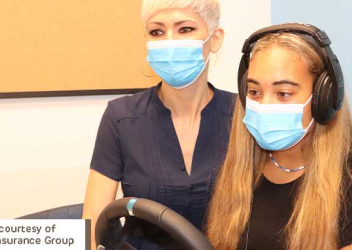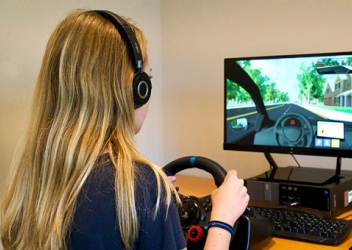Research In Action
Research In Action
Breadcrumb

One of the most meaningful visits I have with my adolescent patients is when I complete their Learner Permit application, but this is also one that scares me. I know that driving is one of the ways that teens become more independent, but I also know that crashes are the leading cause of death for adolescents, with crash rates highest in the months after licensure due to inadequate skills and little experience.
Many parents ask me what they can do to help prepare their teen to be a safer driver. I now have a great answer to give: Check to be sure that your teen has the driving skills needed to drive safely with our virtual driving assessment. Through a partnership with NJM Insurance Group that kicked off in June 2021, Children’s Hospital of Philadelphia began offering this innovative assessment as part of primary care to promote teen driver safety.
The Virtual Driving Assessment (VDA) is a 15-minute virtual driving experience that measures a teen’s ability to drive safety and avoid crashes. The experience is immersive, with teens using a steering wheel, headset and pedals while following the course shown on a computer screen. The VDA is not a substitute for experience on the road, but rather helps teens determine areas where they may be able to improve. They can complete a virtual drive at a CHOP primary care office and then receive high-quality, personalized feedback on their crash-avoidance skills, including tips to improve and links to videos created by CHOP experts to develop specific driving skills.
Piloting the VDA in Primary Care
Through a collaboration with CHOP Care Network Operations, the Center for Injury Research and Prevention, and The Possibilities Project at CHOP, an innovative implementation approach was used to pilot the assessment at five initial practices. Practices received on-site training and the support of a dedicated implementation team. One of the key components to the implementation team’s approach was to acknowledge and encourage each practice to include the VDA in a way that works for their practice. For example, one office may escort teens to the set up before their visit, while others may prefer for them to complete the assessment after their visit.
The assessment was targeted towards new drivers when it was developed which makes it ideal for our patient population. We now offer the VDA to all patients who are at least 15 years old and encourage families to use it multiple times. An especially good time to use the VDA is at the end of the Learner Phase when families are considering going for the licensing exam. Practices now have the ability to schedule the VDA as part of or independently from a routine adolescent visit. Overall, the VDA has been extremely well received by families.
- After taking the VDA, one teen shared: “The driving test [VDA] was the first time I went ‘behind the wheel’ other than trying to learn from observing my parents. I've never learned ANYTHING about driving. This stimulation gave me a chance to finally know what it's like behind the wheel.”
- For many teens, the VDA is a key jumping off point for gaining more driving experience. One teen expressed: “I think it could be a good test to see how well I've learned if I come back after a little more practice.”
- Parents also find the VDA to be a helpful tool to support targeted driving practice.
I, for one, do. As the father of a new driver and a pediatrician, I was so glad to know where to focus attention as my daughter, Maddie, gathered experience behind the wheel. As of August 2022, the VDA is being offered at 11 primary care offices at CHOP, with 11 more practices expected to launch this fall. Over 1,600 adolescents have been screened by the assessment so far.
I look forward to sharing more information with you about this innovative program in primary care in a future blog post.




